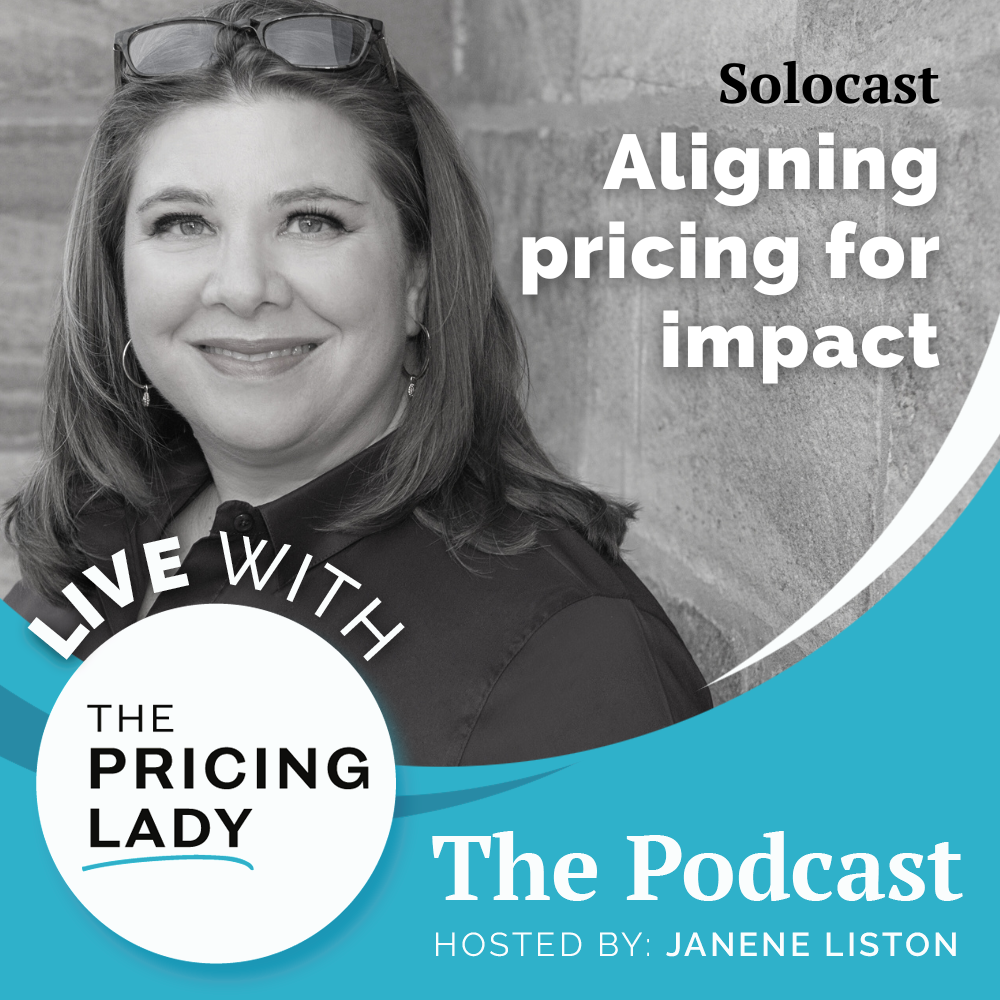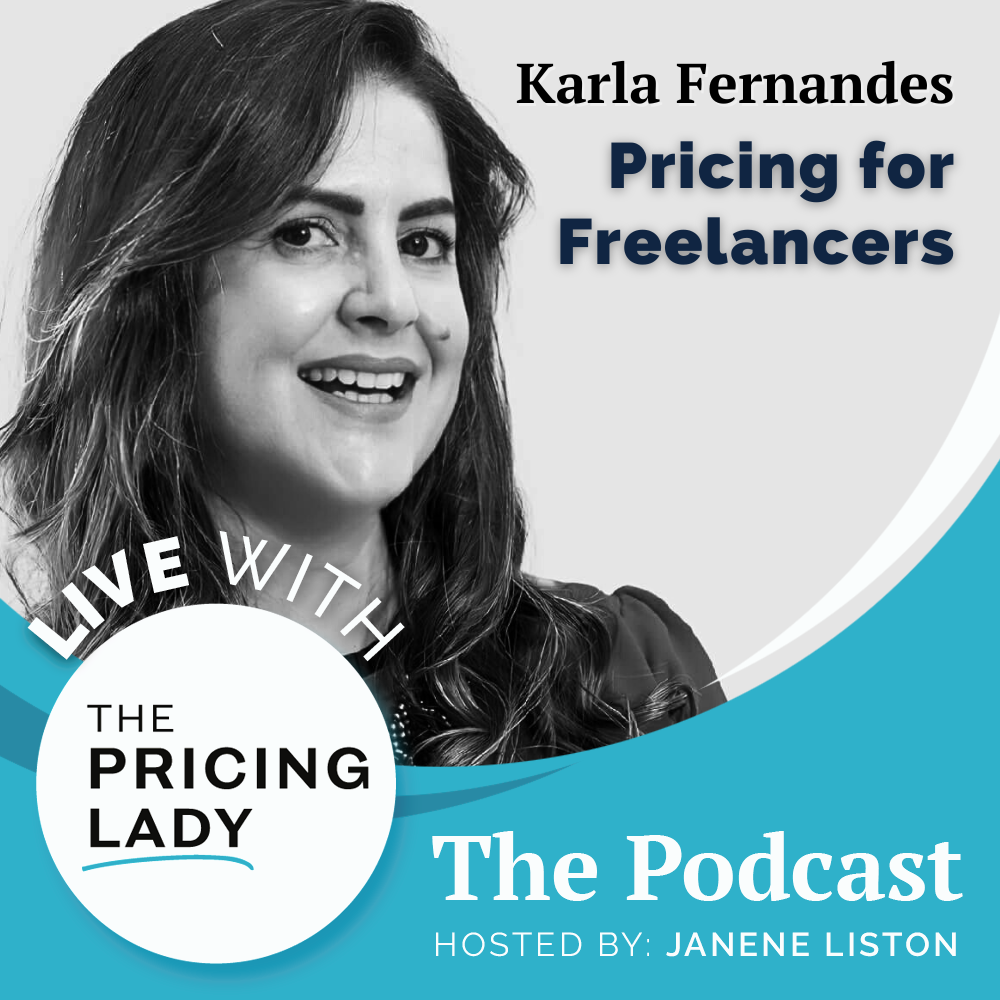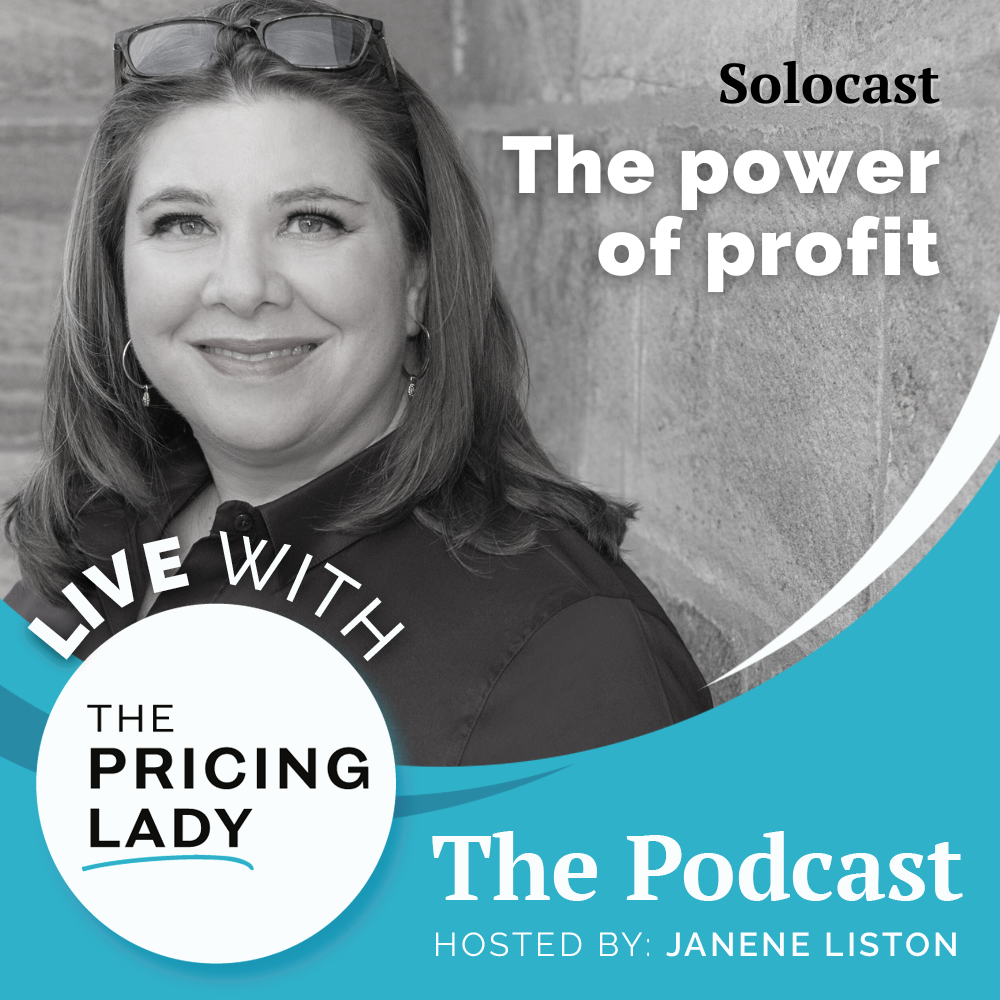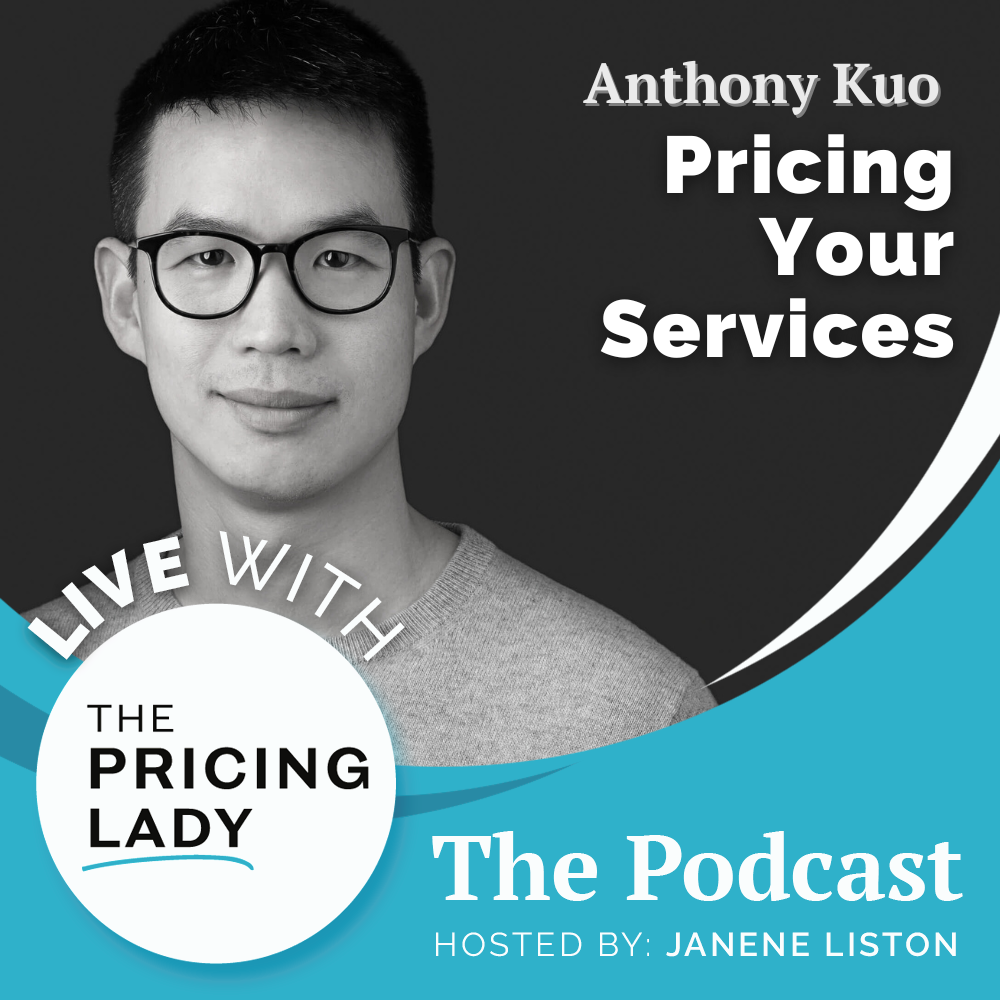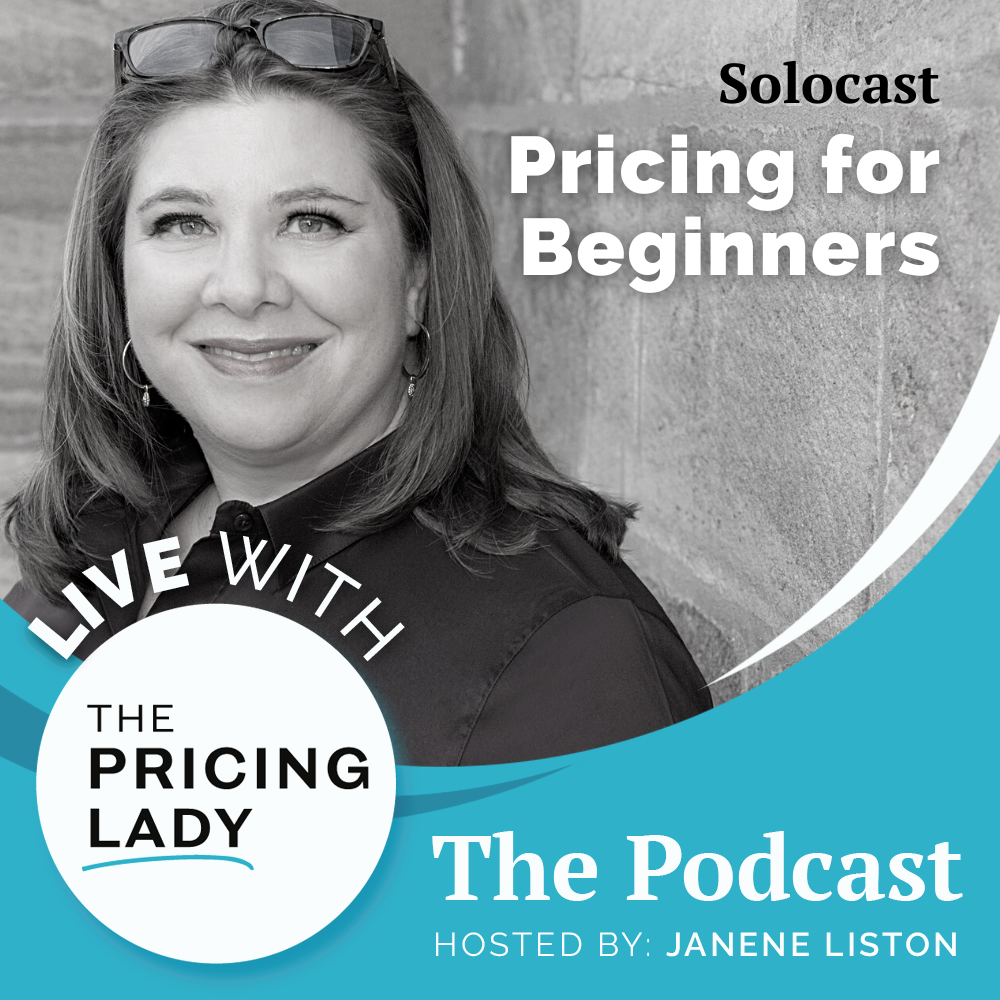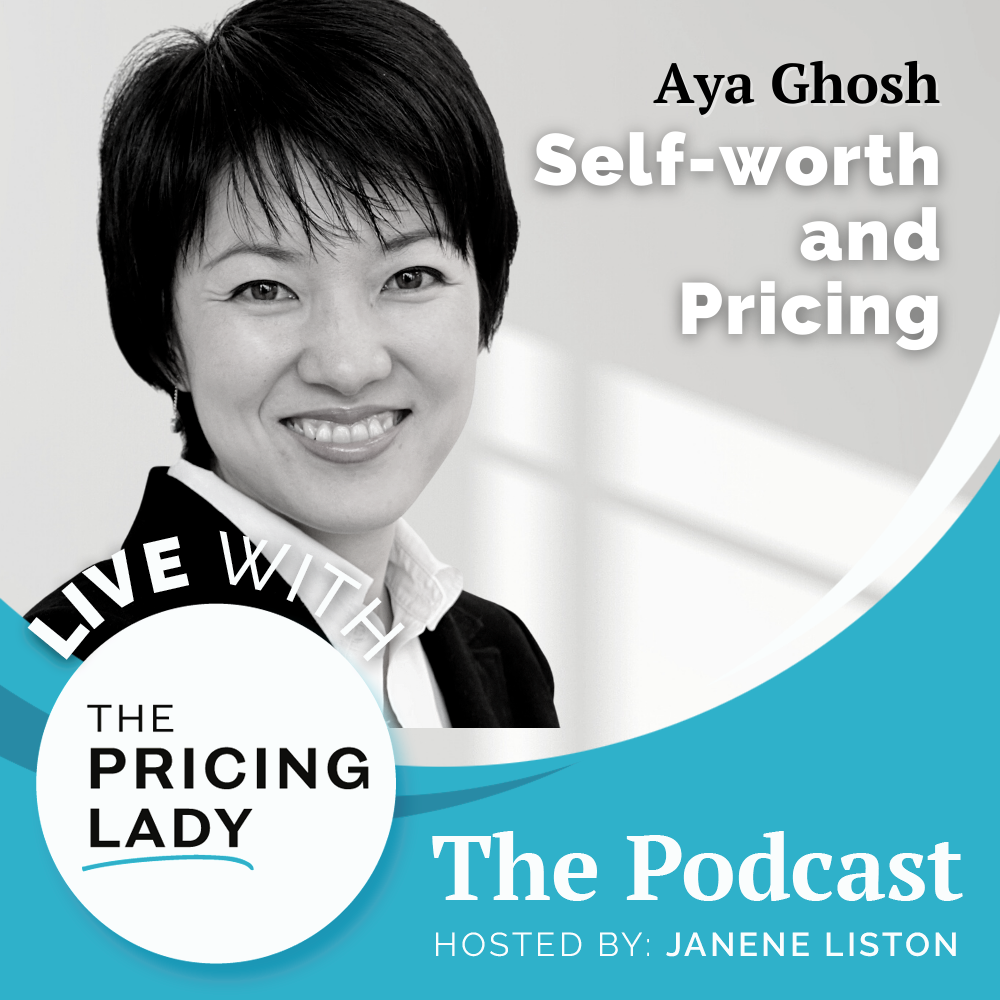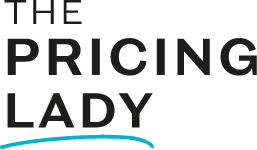Many businesses use cost plus pricing to determine their prices but what is the role costs in pricing?
Cost-plus pricing is one of the most widely used methods for setting prices, but it also more often to not leads to over- and underpricing. While understanding costs is important to having a successful Pricing Strategy and understanding your profit story, relying on them too heavily puts your business at risk. It begs the questions what is cost-plus pricing. what are the disadvantages, why do people use it and if not costs, what should you base your prices on instead.
In This Episode
In this episode, we’re taking a look at the role of costs in pricing.
All of that and so much more. Enjoy the episode.
Podcast Episode Highlights
- 0:00 Intro
- 03:03 Understand What Cost Based Prices are
- 5:00 Limits Flexibility in Your Business
- 06:35 Competition in the Marketplace
- 08:40 Why do People Use It
- 10:16 Costs shouldn’t Determine Your Prices
- 12:03 Understanding the Profit Story
- 13:10 Wrapping it Up
Favorite Quotes
“…for service-based businesses the cost-plus methodology that you tend to use is basing your prices on time.” Janene
“When your price is too low, customers will not be willing to take the chance that it’s a good offer because the price doesn’t seem to match the value that you’re saying it is.” Janene
“Another reason that people use it is they have this idea, this thought that if that’s how much it takes me to produce it, then that means it’s a fair price.” Janene
“If (costs) are the things that customer are thinking about. And (costs) are the things customers use as the basis for making a buying decision, then you’d want to include that when it comes to price setting. But that’s usually not what customers base the buying decision upon.” Janene
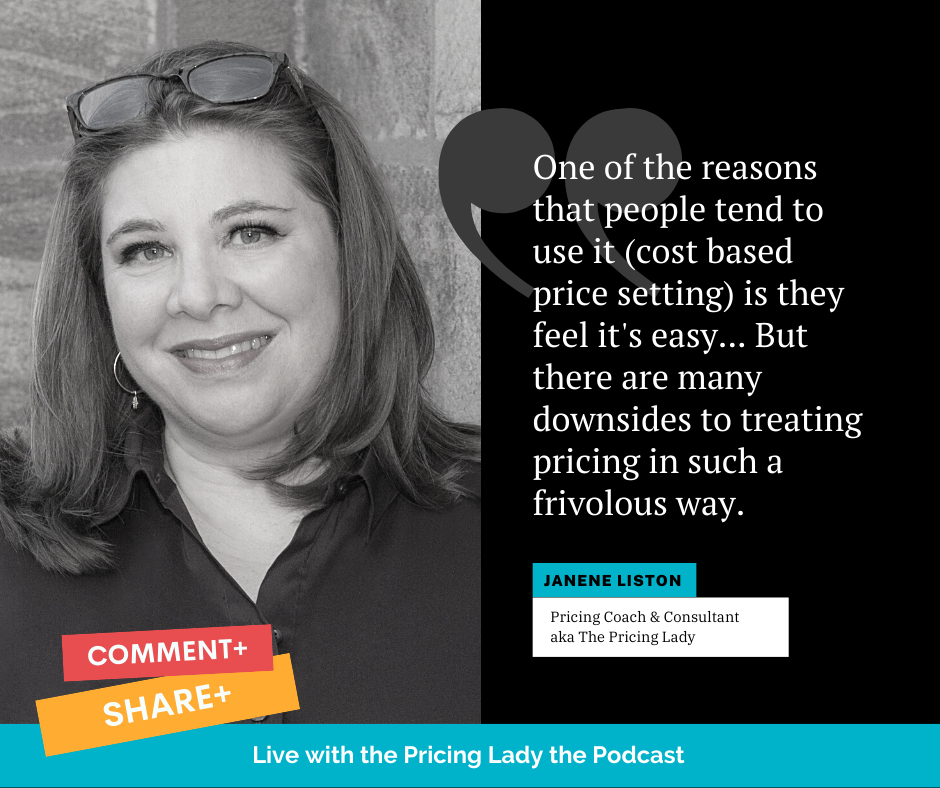
Links for this Episode
Rate, Review and Follow the Show on Apple Podcasts
“I’ve just found my Pricing Resource!” … “A binge worthy podcast.” … “I learned so much about how to improve my profitability.”
If that sounds like you, please consider rating and reviewing the show. It helps me spread the word to more people and ultimately get more small businesses on the path to sustainable profitability and business success. Click right here, scroll to the bottom, tap to rate with five stars, then select “Write a Review.” Last let me know what you loved most about the episode!
One more thing. If you don’t already, follow the podcast. New episodes come out every couple of weeks, plus bonus episode. If you’re not following there’s a good chance you’ll miss something.
Reach Out Connect and Book a Call with Janene
Website | Linkedin | YouTube | Facebook | Email List
Get started improving your business. Sometimes it’s difficult to know where to begin. I suggest you Download the the self assessment Pricing Scorecard. Get a view of what’s working and what’s not working when it comes to pricing in your business. Figure out where to start making improvements.
Get in touch with Janene. If you’ve got a question that needs answering, a challenge you’re facing or you have suggestions for future topics or guests, let me know. Contact Janene.
Listen up! Don’t miss out. There’s a lot going on and you’ll want to be in the know. Follow my YouTube channel (rate it too please) so you don’t miss an episode of Live with the Pricing Lady or join my Email List.
Transform your business and life. My business is about helping you build a better business. One that’s profitable and where you can confidently charge for the value you deliver. Curious about my coaching and consulting offers, check them out. Let’s see how we can work together. Book a complimentary Discovery Call today!
Episode Transcript
Hello, everyone. And welcome to Live with The Pricing Lady, The Podcast. I am Janene Liston, your hostess. This show is all about helping you be more sustainably profitable in your business. My guests and I share with you the tips, the tricks, and the strategies to get the most out of pricing for your business.
In this episode, we’re taking a look at the role of costs in pricing. Now for many businesses costs play way too significant, a role. And recently I’ve had some clients who really put a lot of emphasis on the cost part of their pricing, and oftentimes that can lead to serious over and under pricing. So want to make sure that you guys understand what role costs should play in your business so that you’re doing things in the right way.
Now, let me be clear about one of the things. Now, just because I’m talking about costs does not mean that this episode is only for you product-based businesses. These rules apply for service-based businesses and software based businesses the same. I will add this one caveat for service-based businesses the cost-plus methodology that you people tend to use is basing your prices on time.
And so again, I want you to consider that that may not be the best way or the most appropriate thing to base your prices upon. And I will put in the link of the show, I will put in the dose of this show, a link to another episode that I did about time-based prices that you, if you’re a service-based business may also want to enjoy and learn from.
Understand what Cost Based Prices are
Let’s get stuck right in. The first thing we need to make sure is that we all understand what cost based prices are and it’s actually a strategy or a pricing methodology would say called cost plus. For example, if I was running a lemonade stand and let’s say to produce a glass of lemonade, it costs me $1 and 50 cents.
Now I’m going to use dollars here. You can use whatever currency you want. It really doesn’t matter. I produce a glass of lemonade and it costs me $1 and 50 cents to produce it. A claw cost-plus methodology would say that I add a margin on top of that. That margin is usually representative of my operating costs, plus some profit, but I add a margin on it to determine the selling price.
Let’s say my margin is 50%. That means that if it costs me one and a half dollars to produce it and my margin is 50%, my selling price would then be $2 and 25 cents. That is simply what cost plus pricing is. There’s some real disadvantages to cost-plus pricing. Let’s take a look at seven of those.
I’ve got a few for you here. The first one is that it’s very inward focused. When it comes to setting (cost-based) prices, you’re setting on something that is internally focused and completely ignores anything outside of the business, like your customers and the competition in the marketplace and the value and the willingness to pay.
I can go on and on. So is this extremely inward-focused especially when your businesses are getting bigger. It means not only are you and really focused, but then your team becomes inwardly focused and so on and so forth. That can lead to real problems later on.
Limits Flexibility In Your Business
Reason number two, it limits differentiation. What you often find in companies that use a cost-plus methodology is they apply one margin to everything in the business or to one whole product line, but that really limits your ability to have prices at different levels for different situations or different customers or different offers. And that really limits your flexibility in your business and being able to meet customers at different value points. Reason number three, it ultimately leaves the vast majority of the time to over and under priced.
There’s just no way around it, because it’s not based on anything that is related to how the customer makes the decision about what they’re going to buy. So it couldn’t just magically happen to land on the perfect price. Although I will say maybe from time to time, it comes out in the right area, but usually it will lead to either underpricing or overpricing, which is precisely what you don’t want.
Reason number four, it totally ignores the customer. The person who’s actually making the decision about what to buy and whether or not to buy it and whether or not that’s a fair price. It completely takes them out of the equation and they can Norse them, which to me is a really big no-no. In that context, it, it completely ignores customer willingness or ability to.
Competition in the Marketplace
Number five, it totally ignores the competition in the marketplace. By applying that 50% margin on top of my lemonade, I may be pricing myself outside of this because I’m ignoring that there’s two other lemonade stands on my street and they both turned significantly less than that.
Or I could be leaving money on the table because both of them charged $5 and I could be charging maybe as much as them. Maybe I could be charging more, but it completely ignores what’s going on in the marketplace and your competition. That is another disadvantage to cost-based pricing. Two more for you.
It becomes a bit addictive, right? Once you start pricing based on costs, then anytime you have an issue with price, you default to adjusting something on the cost side and vice versa. If something goes changes with your costs, you’re left with adjusting your prices. And the market may not be able to, to bear that on the one hand, but it just becomes this habit that you get into.
That’s really hard to get out of it. The last disadvantage is that it seriously undermines your value and your positioning. And this, again, it goes back to the fact that it ignores the customer and the competition or the market. Therefore it can really have an impact on if you’re underpricing, how people perceive the quality of what you’re delivering to them, right?
When your price is too low, customers will not be willing to take the chance that it’s a good offer because the price doesn’t seem to match the value that you’re saying it is. It can really create habit for you in terms of actually selling your home. So those are seven disadvantages of cost plus pricing.
Why do People Use It
So now that we understand what it is and what the downside of it are, why do people use it? I mean, this is a really good question, right? If it’s so bad, then why do people use it? Well, one of the reasons that people tend to use it is because they feel that it’s relatively easy to take the cost that they have and add them up and slap a margin on it and be out the door.
But as you’ve just heard, there are so many downsides to treating pricing in such a frivolous way. That it’s a real risk for your business if you’re relying solely on a cost based methodology. They feel that the costs are known, which is part of what it makes it feel so easy. Another reason that people use it is they have this idea, this thought that if that’s how much it takes me to produce it, then that means it’s a fair price. They think that cost plus is justifying the fairness of their price. But as I pointed out before, there are other things that determined the fairness of the price, like what the customer is willing to pay and the value they get out of it.
Those things are related to the thought process. The customer goes through when they’re making a purchase, whereas the costs are not. Right. Maybe I said this before. I can’t remember if I said it, but you know, the last time you bought a tomato, did you think about how much it costs the farmer to produce it?
Costs shouldn’t Determine Your Prices
Then how much it costs the middleman to get it from the farmer to the grocery store and then how much it costs the grocery store to have it there for you before you decided if that was a fair price for your ticket. Well, of course you did. You’d never leave the grocery store. If that was how you thought about each and every purchase you made.
In general customers, aren’t adding up the costs of the last, you know, of how much they think it takes a TV supplier to produce a TV before, you know, in their head. They’re not adding up those classes in their head before they’re deciding if it’s a fair price for their new flat screen. Because that would be prohibitive.
What they are thinking about is how much money they have in their wallet or how much money they think it’s fair to spend, or the value that they’re going to get from that tomato or from that TV. If those are the things that customers are thinking about. And those are the things that customers are using as the basis for making the buying decision.
Then those are the things that you want to include when it comes to setting your prices. That is really the crux of this whole conversation today. It’s that cost should not determine your prices. Things like value in the marketplace, willingness to pay. Those are what your prices should be based upon.
So caution, determined prices, but they should be used to indicate and understand whether or not you can sell, produce and sell your offer at a profit. And what it’s going to take to have the profit that you want to achieve.
Understanding the Profit Story
This is one of the reasons why I’m always telling, especially young businesses, that the sooner you get started with pricing, the sooner you can understand the profit story and the profit story is what you’re going to want to be communicating to potential investors, to business partners, to the bank if you need to get a loan. If you don’t understand that profit story, than you’re going to have a hard time getting that business up and off the ground. Even if you don’t need investors, you need to understand how much, of what, you need to sell to whom, at what price in order to have a profitable business.
This is where costs play a role in pricing. They help you to understand that profit picture and ensure that the prices that you’ve set based on the market and the customer and the value that those prices that you’ve said help you to either understand how profitable you can be or how much volume you’re going to need with those costs and those prices in order to hit the profitability levels that you would like to achieve.
Wrapping It Up
That is what I wanted to share with you today. The role of cost and pricing is really helping you to understand profitability, not the basis of determining your prices. I hope you enjoyed this episode today. This is a topic that is near and dear to my heart. If you’ve got questions or would like to share with me, what’s going on in your business and find out more about how to work together, please head on over to www.thepricinglady.com and book a discovery call with me.
We can find out what’s going on in your business and how I might be able to help you. I wish you all the best everyone. Have a fantastic day and as always, enjoy pricing.

